Vera Olkhovskaya
Why sew a winter coat when you can buy one? What are the most common defects in the fit of a factory coat on a female figure? How to choose fabric? How to choose a lining? How to choose a heater? How to make a coat warm? What should be taken into account so that you can easily raise your hands in a coat? What should be taken into account so that the products are not blown in the area of \uXNUMXb\uXNUMXbthe inflection of the lapel? What should be taken into account so that the sides do not diverge? What should be taken into account when cutting? .. All these questions torment us with the onset of cold weather. But now they have answers!
 Why sew a winter coat when you can buy one?
Why sew a winter coat when you can buy one?
Answer: To ensure that the quality of the product matches its price and your expectations. Least the coat must be
a) warm enough to keep warm in windy weather with frost up to 150 FROM,
b) comfortable
c) and sit well on the figure.
But, if you are buying a coat, then be prepared to the fact that you are purchasing a product made of cheap imported fabric with a low content of wool or consisting entirely of synthetic fibers. Such fabrics do not protect from the cold and even more so from the wind. A coat without insulation will warm you only in calm weather, if the temperature does not drop below +50 C. But it will dry quickly and will not lose shape if you get under
rain.
For insulating lining in the vast majority of cases today they use a synthetic winterizer or batting made of artificial or synthetic fibers. When buying, remember: batting, even synthetic, gives more warmth and does not lose volume when worn, like a synthetic winterizer.
Synthetic batting, an insulating artificial or synthetic “top”, will warm you if the temperature does not drop below minus 20 C.
It should be noted that a synthetic winterizer as a heater is suitable only for products made of thin raincoat fabric that does not allow air and water to pass through. Only under raincoat fabric does it not wrinkle and provides a sufficient level of comfort at positive temperatures in wet windy weather and in slight frost.
What are the most common defects in the fit of a factory coat on a female figure?
Answer:
a) insufficient or simply poor fit in the area of the middle seam of the back - horizontal or inclined folds, baggy in the waist at the back, the coat "jumps" on the buttocks, etc .;
b) the wrong choice of silhouette - the product is large in the shoulder area and narrow in the hip area, due to which a jam is formed in front in the inguinal fold area and / or the floors diverge;
c) protrusion of the product along the inflection of the lapel - the balance of the product that is not suitable for the figure;
d) the product is narrow in the chest - if you raise your hand, it is exposed almost to the elbow and the product rises strongly;
e) narrow head of the sleeve - the same effect when raising the arm;
e) low armhole - the same effect.
Quite often, you can observe several landing defects at once + cheap low-quality fabric.
Answer:
a) it is easier to work with “loose” fabrics (for example, boucle) than with “dense” ones (for example, drape, cloth) - they take the desired shape more easily and flaws in cutting and processing are less noticeable on them;
b) if you choose a fabric with a pile, keep in mind that the details of the cut should be located in the same direction, and this will increase the consumption;
c) pure wool fabrics are very rare today, but they shrink significantly when wet, therefore they require strict adherence to the technology of wet-heat work and, as a result, special skills from the tailor;
d) the best option would be a blended fabric (wool + synthetics), since it is easier to process it and it keeps its shape well, and the presence of woolen fibers will make the product warm enough;
e) purely synthetic fabrics should be avoided, although they are quite easy to process;
f) to check the composition of the fabric, burn a couple of threads (synthetics melt, artificial fibers burn like paper, and burnt wool smells like horn and crumbles) - you will find out which fibers prevail in it (sorry, this cannot be done before buying).
How to choose a lining?
a) do not take a cheap or very thin lining - it is highly electrified and therefore does not slide well;
b) for a winter coat, satin will be optimal, you can even dress and the heavier it is, the better;
c) the color can be both contrasting and matching the fabric of the top.
How to choose a heater?
a) insulation is the biggest problem for a winter coat;
b) synthetic winterizer - NOT SUITABLE;
c) it is desirable to choose woolen batting, but (alas!) this is almost never done today;
d) the way out is to rip batting from old grandmother's coats or use an old downy scarf instead (it is also fastened on gauze, then on the lining).
How to make a coat warm?
a) wool insulation + drawstring lining of sleeves;
b) double batting - the second layer only on the upper half of the sleeves, on the back and the shelf does not go under the arms and reaches the middle of the thigh, while the first layer “doubles” the lining completely and reaches the knee in length;
c) lining made of wool or natural fur.
d) in addition to the listed options, a double-breasted fastener should be recommended, that is, the largest possible smell.
What should be taken into account so that you can easily raise your hands in a coat?
a) high armhole
b) wide head of the sleeve,
c) sufficient width of the shelf and back.
What should be taken into account so that the products are not blown in the area of \uXNUMXb\uXNUMXbthe inflection of the lapel?
a) "raise" the shelf at the neck;
b) slightly increase the solution of the tuck for the chest.
What should be taken into account so that the sides do not diverge?
The divergence of the sides has two reasons: cut errors and incorrect processing.
a) the most common mistake of beginners is inaccuracies in taking measurements and drawing up a drawing, it is especially important to accurately take balance measurements (see Product balance);
b) duplicate the shelf and the pick, while the distance between the dubbing of the shelf and the dubbing of the pick should be 0,5 cm - see fig. one;
c) lay a dense adhesive edge along the edge of the bead (directly on dubbing) and along the edge of the edge (also on dubbing) - fig. 2;
d) lay 2 - 3 machine lines along the selection (along the adhesive edge);
c) when ironing the shelf, place it with the side towards you and the fold of the side (with a one-piece selection) must be parallel to the edge of the ironing table.
What to consider when cutting:
a) in styles where the edge of the bead is parallel to the half-skid, the bead (or part of it) must be one-piece;
b) the direction of the shared thread of the shelf and dubbing must strictly coincide with the line of the half-skid;
c) for some types of figures, the choice of the basis of the cut plays a decisive role (for example, an X-shaped silhouette is not recommended for “apples”) and style, since it is difficult to put an incorrectly chosen style on a figure.
Comments to the photo of the coat.
Double-breasted winter coat with two semi-reliefs, 1-loop closure, X silhouette. Description of the pattern in the "Cutting Technique", part 2, ch. 1.2.
Turn-down collar of the English type with a high cut-off stand.
The product is sewn from ladies' rattan, the fur is artificial. Second-hand pure wool knitted fabric (down scarf) and second-hand woolen batting were used as an insulating lining. Lining - dress satin.
Patterns of women's coats, fur coats and jackets
Women's coats Fur coats Jackets Capes


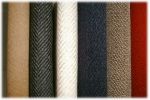
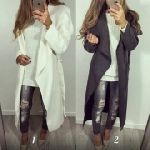
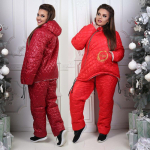



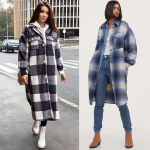
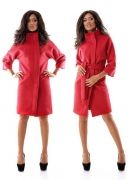


 Join my community on Viber...
Join my community on Viber...











